Geometric Calibration Updates to Landsat 7 ETM+ Instrument for Landsat Collection 2 Products
Abstract
:1. Introduction
- (1)
- An update to the thermal band detector alignment. A detector-to-detector misalignment was determined to be present within the thermal band just after generating the Collection 1 data set. Upon inspection, the prelaunch detector alignment values for the thermal band appeared to contain small residual errors, less than 15 micro-rdaians (µrad). This misalignment, which was part of the prelaunch characterization of the thermal band, was small and only visible under ideal situations. A complicating factor in this odd–even detector alignment is the fact that the current geometric correction of the ETM+ data does not account for the change in scan mirror velocity caused by the switch from scan angle monitor (SAM) to bumper mode operation [6]. Although this effect is also very small, when combined with the error arising from the prelaunch alignment calibration, it would allow for the offsets between odd and even detectors to be at times visually identifiable. For Collection 2, only the prelaunch calibration portion of this effect was accounted for. The correction due to the velocity change for the switch in the mirror’s operational mode will be part of a subsequent collection reprocessing. This detector-to-detector alignment adjustment will improve upon the thermal band co-registration to the other ETM+ bands, remove the visual artifact of jagged edges on features that otherwise would be a smooth edge, and improve upon its internal geometric accuracy.
- (2)
- An update to the warm to cold focal plane adjustment. Like the thermal band odd-to-even detector calibration, this adjustment was also small, less than 5 µrad. These changes, which occurred throughout the mission, were most likely caused by changes within the program and how the instrument was managed. The first change was attributed to the scan line corrector (SLC) failure. The second to the switch from the SAM to the bumper mode control of the scanning mechanism. The third occurred after the launch of the Landsat 8 (L8) system, at which point the duty cycle of the ETM+ changed based upon the success of the L8 instruments. This adjustment was performed to improve consistency in time of the band-to-band alignment across the full mission timeline.
- (3)
- An update to the ETM+ sensor to attitude control system alignment. Prior to the switch to bumper mode, this alignment was stable, except for a shift that occurred during the launch of the spacecraft itself, as the calibration parameters remained stable during normal SAM mode operations. After the switch to bumper mode, a consistent change has been shown to occur with this alignment. Finding whether this alignment was due to the coupling between the switch to this mode of operating the mirror and the sensor alignment parameters has not been determined. This adjustment improves upon the level-1 systematic terrain ETM+ products, products, which perform a terrain correction to the data in the absence of being able to apply an adjustment based on ground control. This adjustment also achieves a better relative placement of the systematic image before correlating the image against the Landsat ground control library, which could, in turn, improve upon the correlation measurements.
2. Materials and Methods
2.1. Thermal Band Odd to Even Detector Alignment
2.2. Focal Plane Alignment
2.3. Sensor Alignment
3. Results
3.1. Thermal Band Odd to Even Detector Alignment
3.2. Focal Plane Alignment
3.3. Sensor Alignment
4. Conclusions
Author Contributions
Funding
Institutional Review Board Statement
Informed Consent Statement
Data Availability Statement
Conflicts of Interest
References
- Goward, S.N.; Masek, J.G. Landsat 30 years and counting. Remote. Sens. 2001, 78, 1–2. [Google Scholar] [CrossRef]
- USGS. Landsat 7 Image Assessment System Geometric Algorithm Theoretical Basis Document. U.S. Geological Survey: Sioux Falls, SD, USA. 2006. Available online: https://www.usgs.gov/media/files/landsat-7-image-assessment-system-geometric-atbd (accessed on 21 February 2021).
- Lee, S.L.; Storey, J.C.; Choate, M.J. Four years of landsat-7 on-orbit geometric calibration and performance. IEEE Trans. Geosci. Remote Sens. 2004, 42, 12. [Google Scholar] [CrossRef]
- Markham, B.L.; Haque, O.; Barsi, J.A. Landsat-7 ETM+: 12 years on-orbit reflective-band radiometric performance. IEEE Trans. Geosci. Remote Sens. 2011, 50, 2056–2062. [Google Scholar] [CrossRef]
- USGS. Landsat 7 Data Users Handbook. U.S. Geological Survey; Sioux Falls, SD, USA. 2019. Available online: https://www.usgs.gov/media/files/landsat-7-data-users-handbook (accessed on 20 April 2021).
- Storey, J.C.; Choate, M.J. Landsat-5 bumper-mode geometric correction. IEEE Trans. Geosci. Remote Sens. 2004, 42, 12. [Google Scholar] [CrossRef]
- USGS. Landsat Collections. Available online: https://www.usgs.gov/core-science-systems/nli/landsat/landsat-collection-2?qt-science_support_page_related_con=1#qt-science_support_page_related_con (accessed on 20 April 2021).
- USGS. Landsat 7 ETM Level 0 Reformatted Product Data Format Control Book; Technical Report; Department of the Interior, U.S. Geological Survey, EROS: Sioux Falls, SD, USA. 2018. Available online: https://www.usgs.gov/media/files/landsat-7-etm-level-0-reformatted-product-data-format-control-book (accessed on 21 February 2021).
- USGS. Landsat 7 Calibration Parameter File Definition. Technical Report; Department of the Interior, U.S. Geological Survey, EROS: Sioux Falls, SD, USA. 2018. Available online: https://www.usgs.gov/media/files/landsat-7-calibration-parameter-file-definition (accessed on 21 February 2021).
- Rengarajan, R.; Sampath, A.; Storey, J.C.; Choate, M.C. Validation of geometric accuracy of global land survey (GLS) 2000 data. Photogramm. Eng. Remote Sens. 2015, 81, 2. [Google Scholar] [CrossRef]
- Storey, J.; Roy, D.P.; Masek, J.; Gascon, F.; Dwyer, J.; Choate, M. A note on the temporary misregistration of landsat-8 operational land imager (OLI) and sentinel-2 multi spectral instrument (MSI) imagery. Remote Sens. Environ. 2016, 186, 121–122. [Google Scholar] [CrossRef] [Green Version]
- USGS. Preliminary Assessment of the Value of Landsat 7 ETM+ Data following Scan Line Corrector Malfunction. Technical Report; Department of the Interior, U.S. Geological Survey, EROS: Sioux Falls, SD, USA. 2003. Available online: https://www.usgs.gov/media/files/preliminary-assessment-value-landsat-7-etm-slc-data (accessed on 29 March 2021).
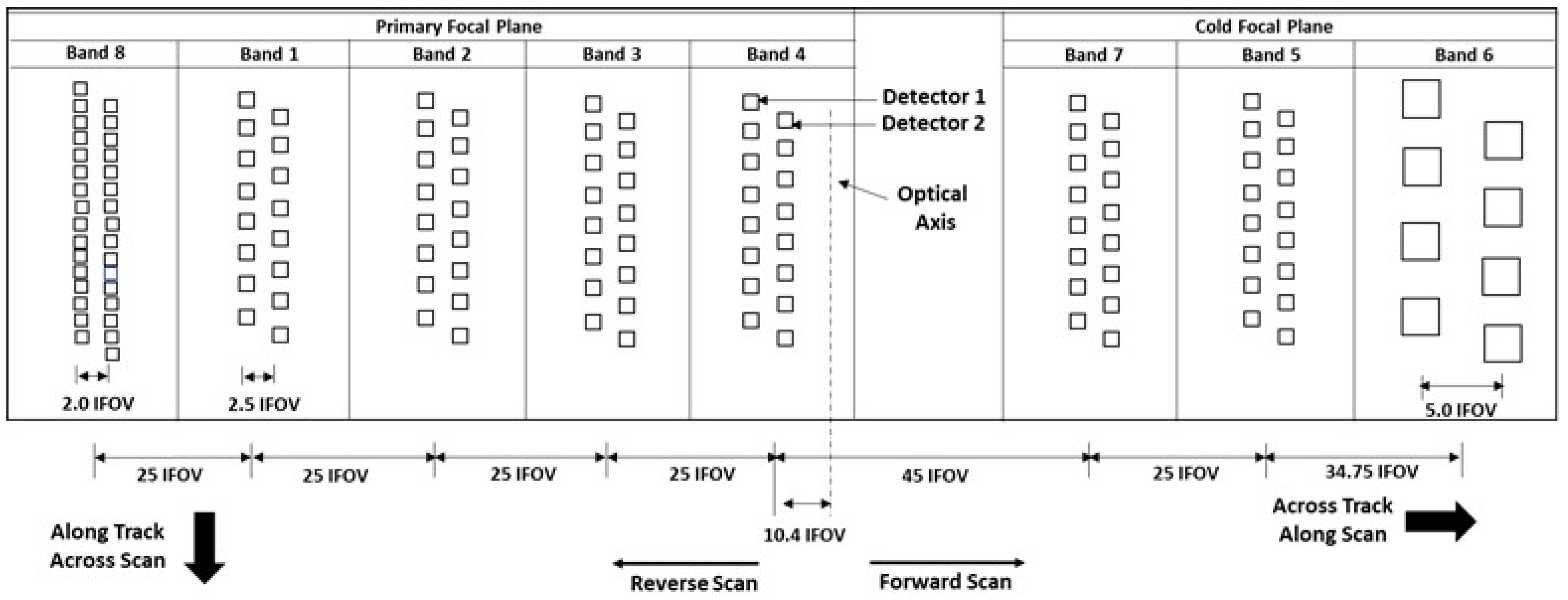
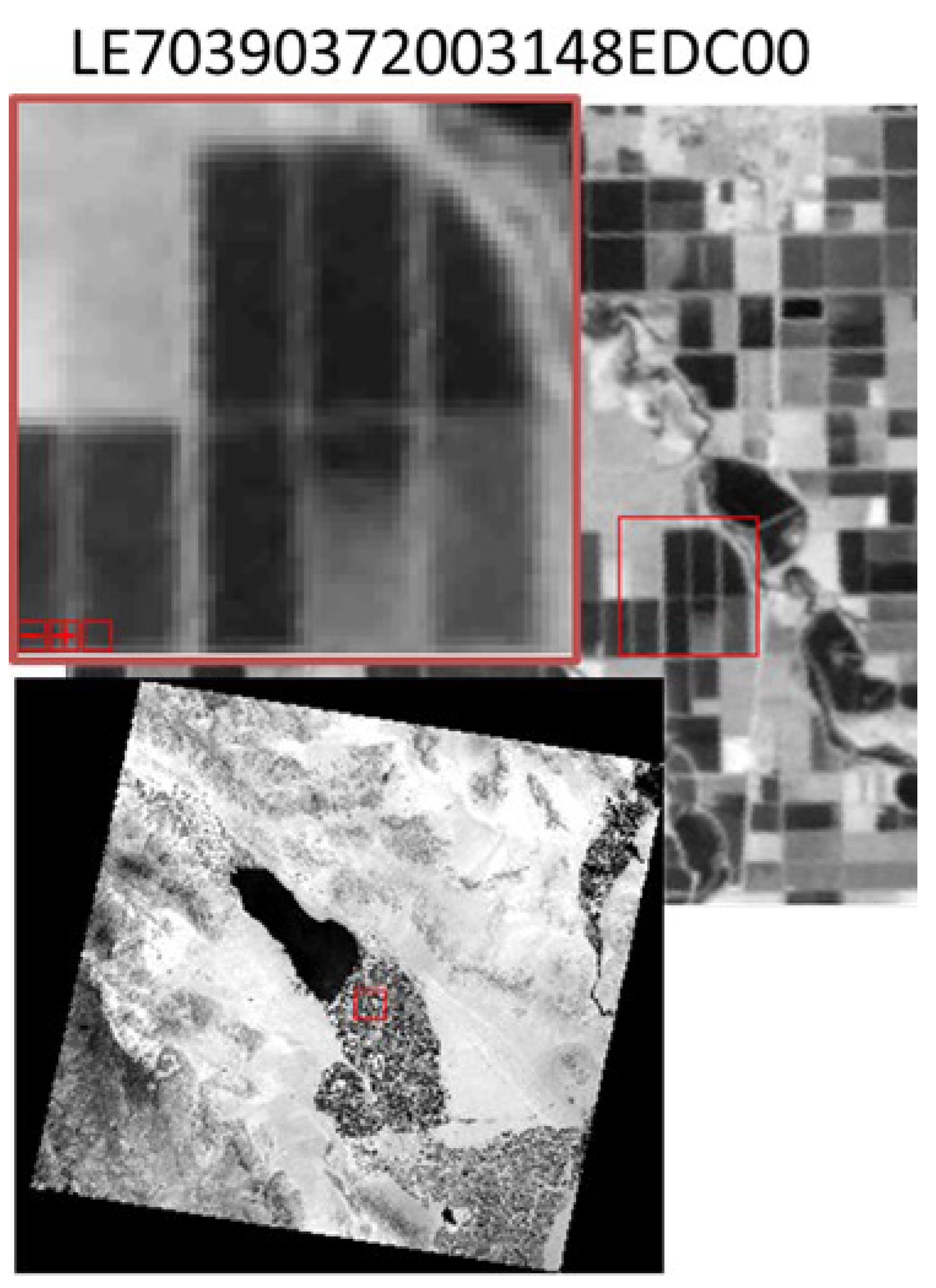
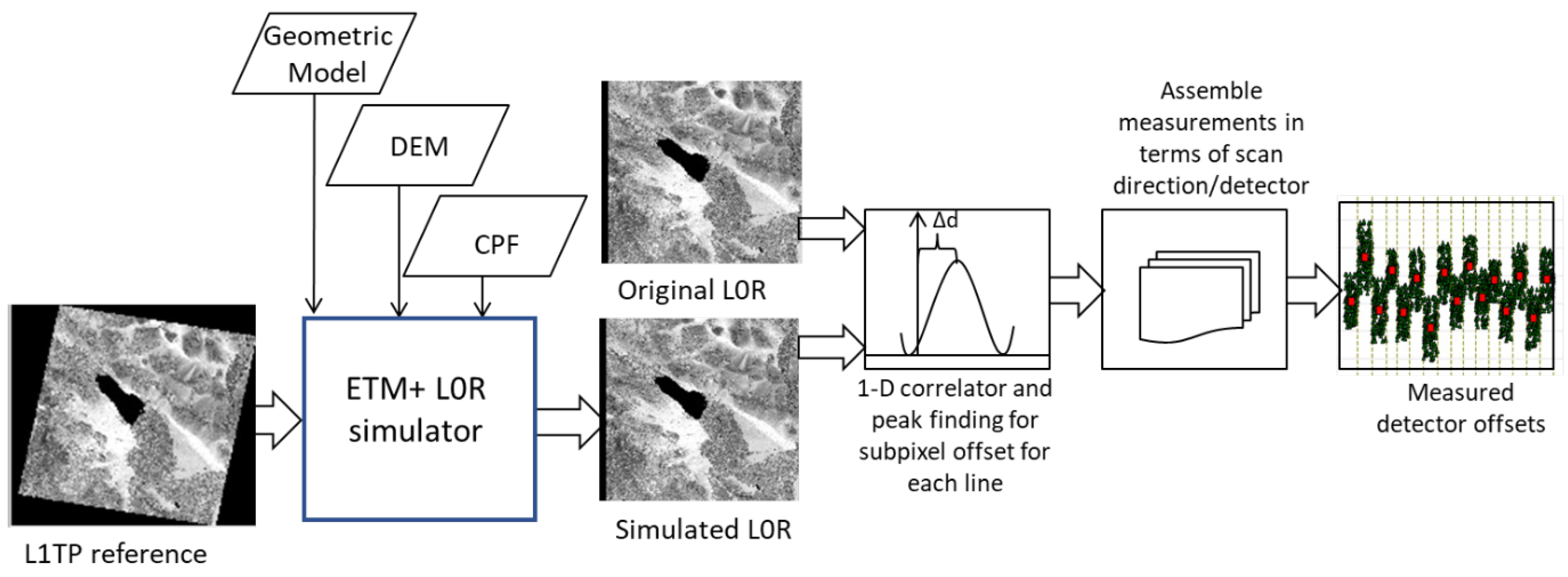
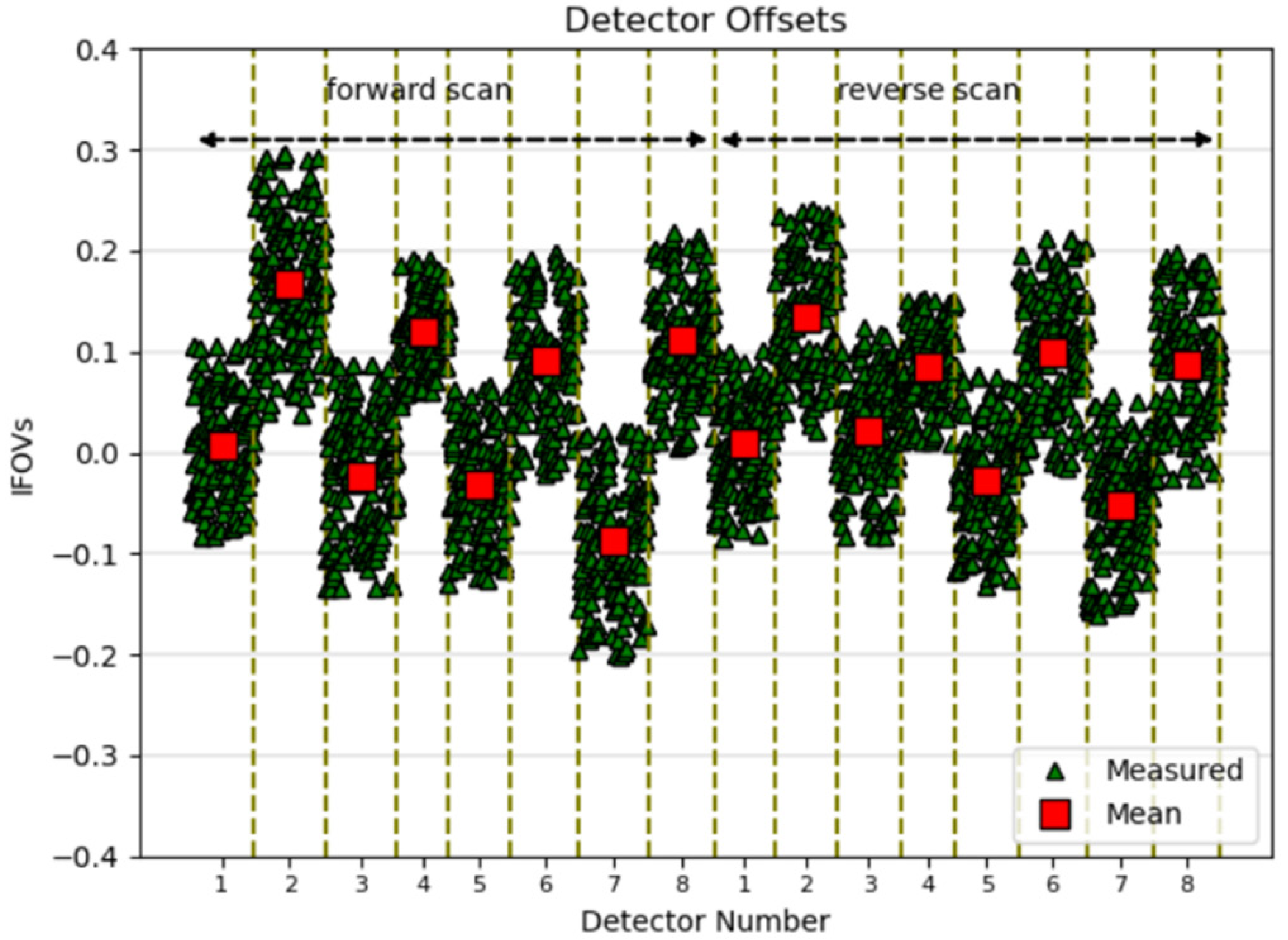


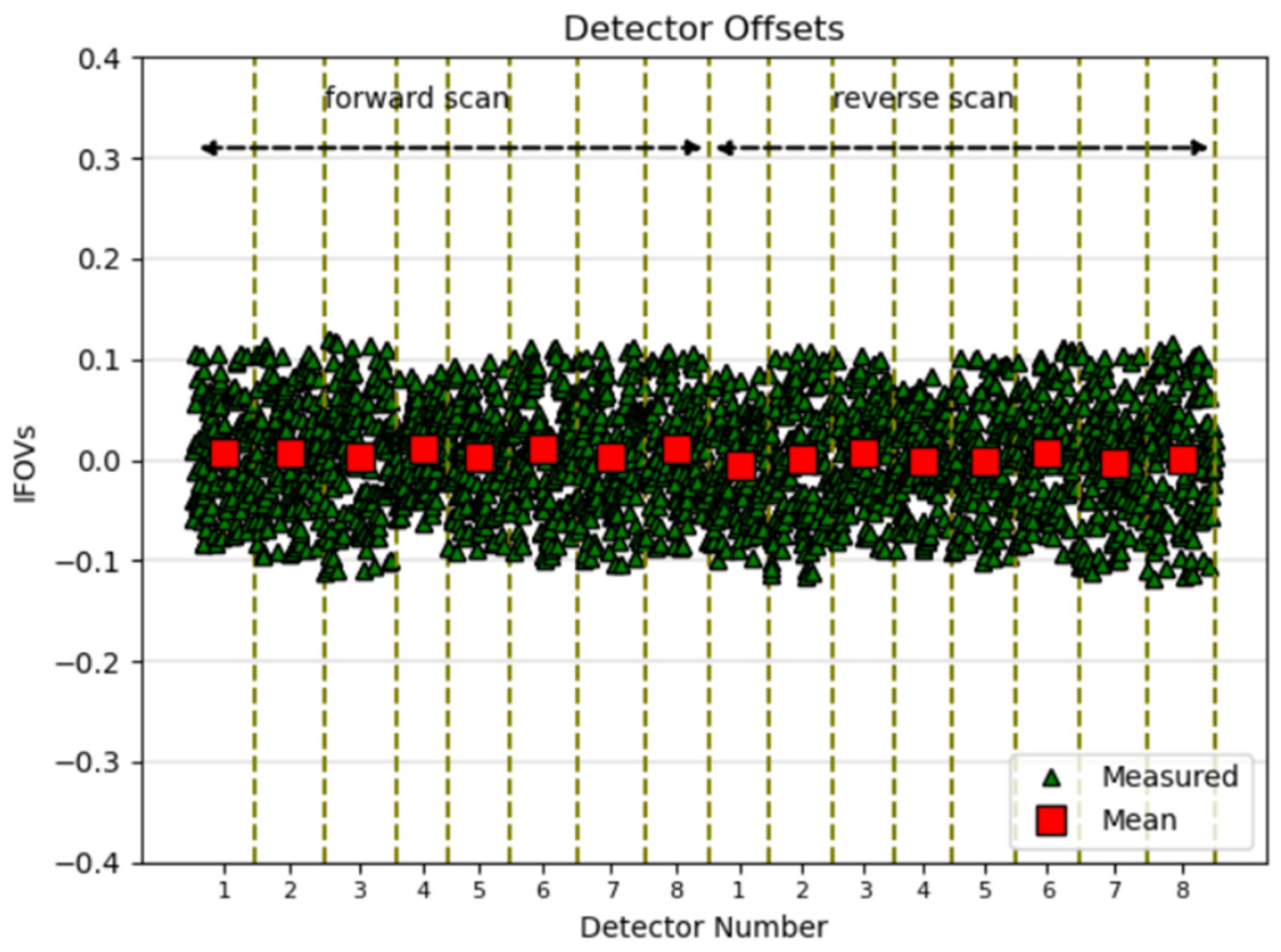


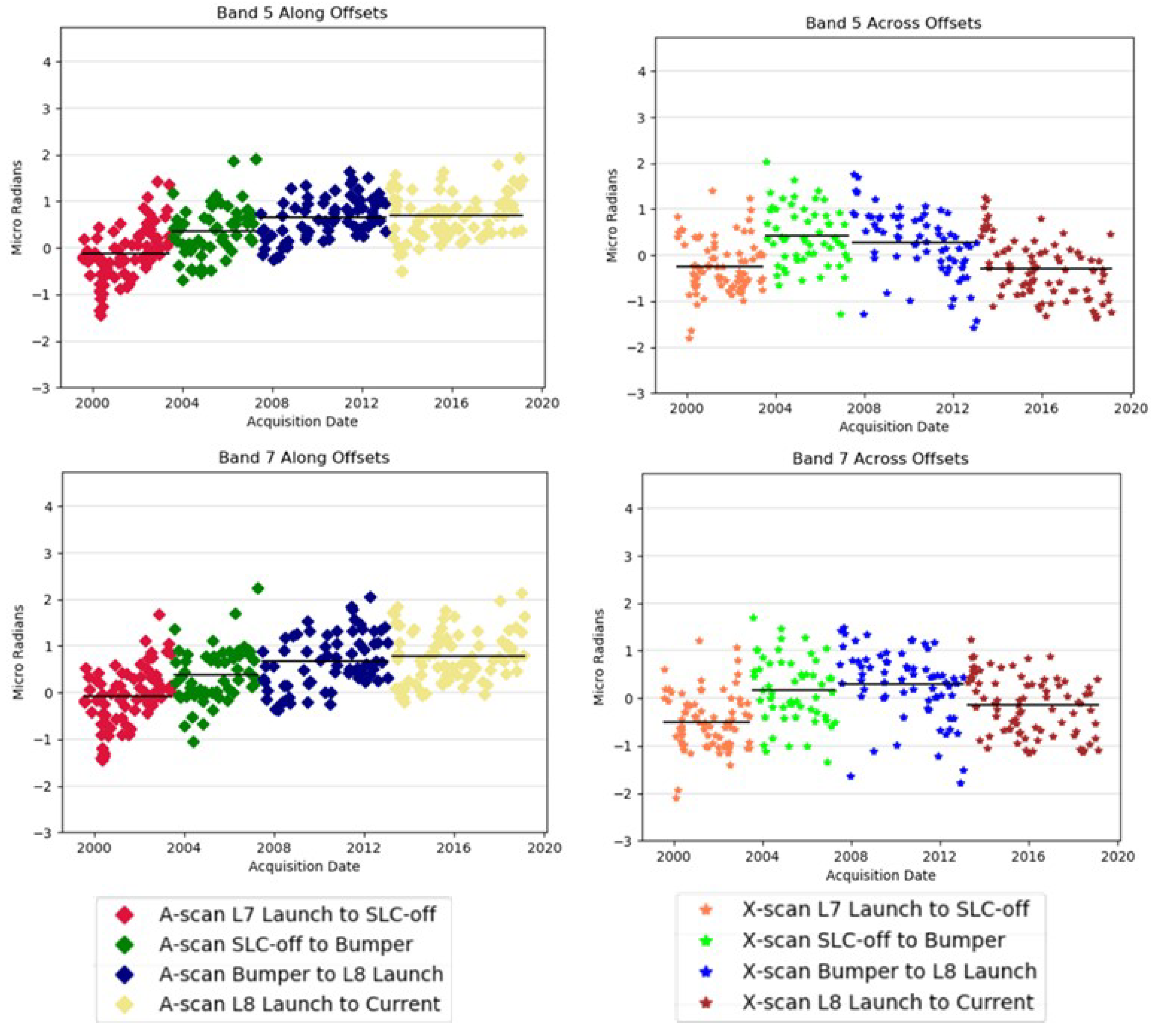
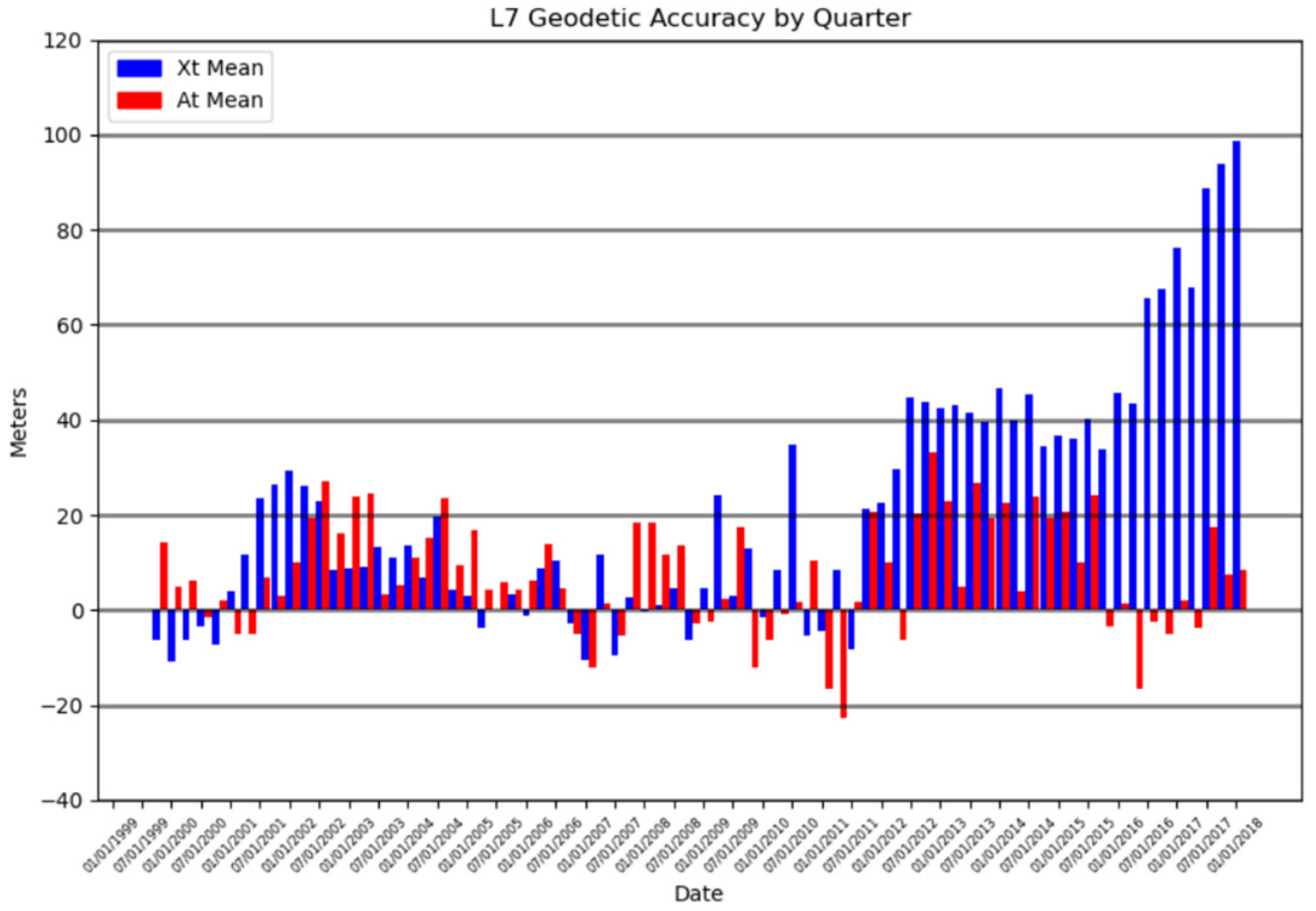
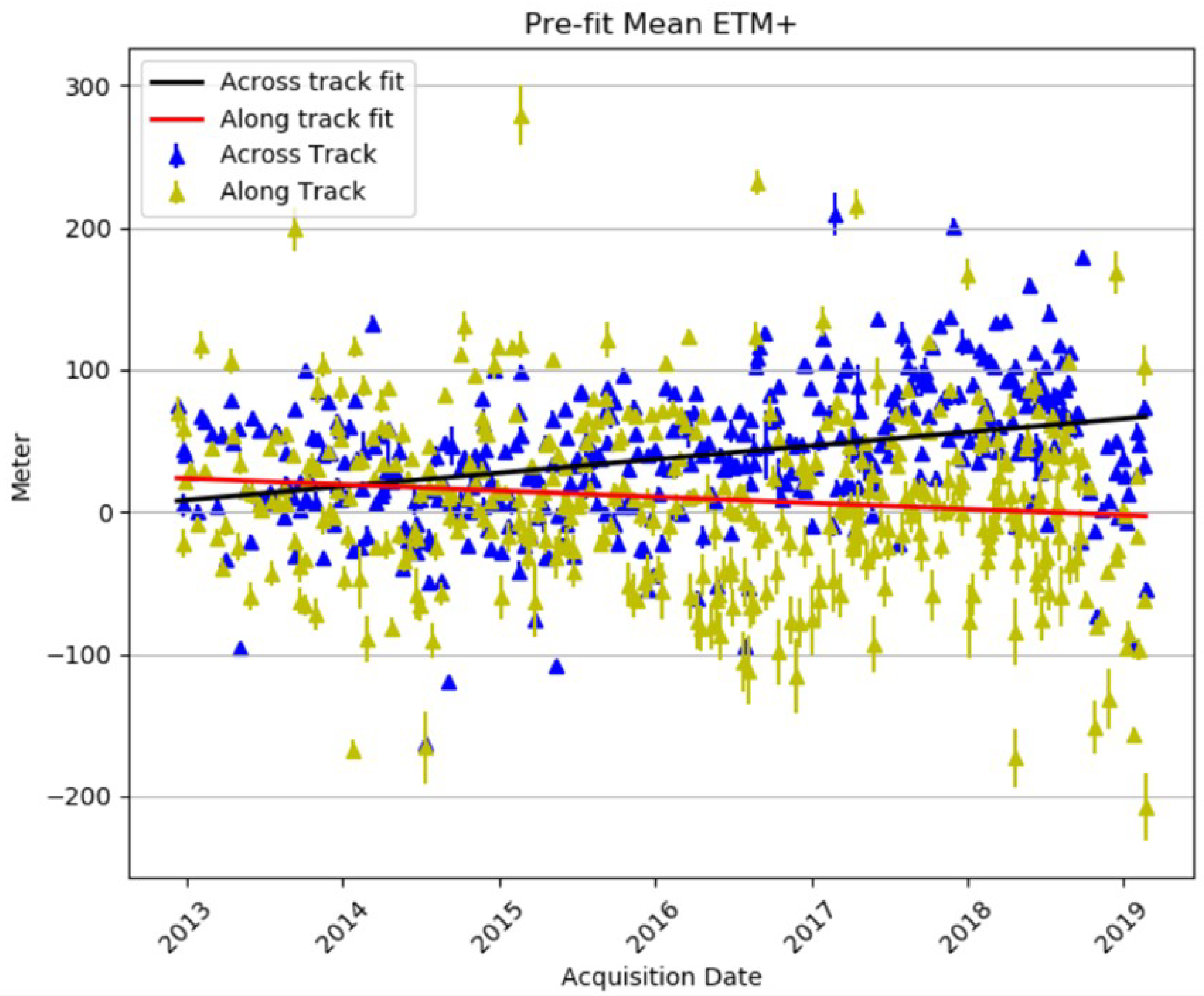
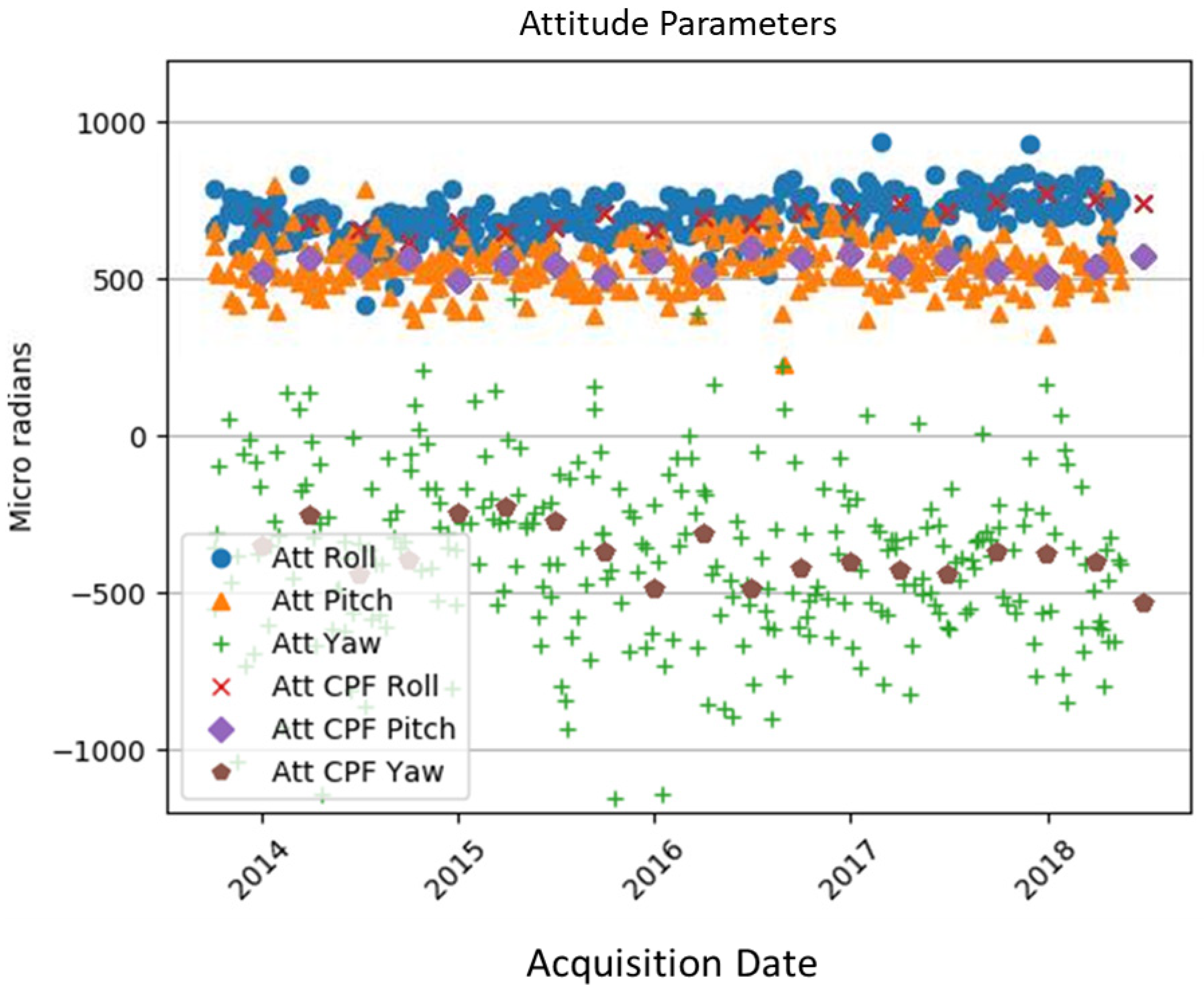
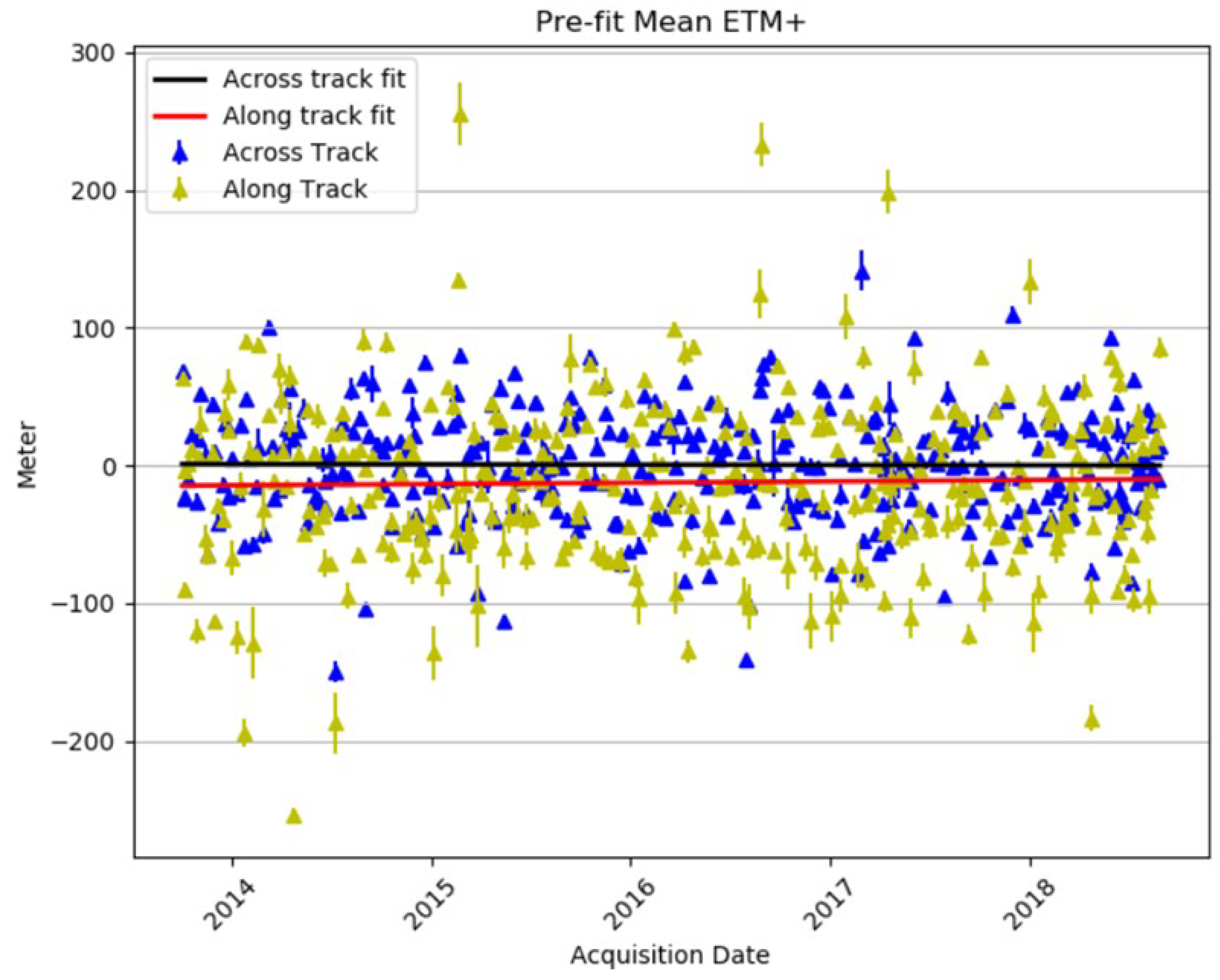
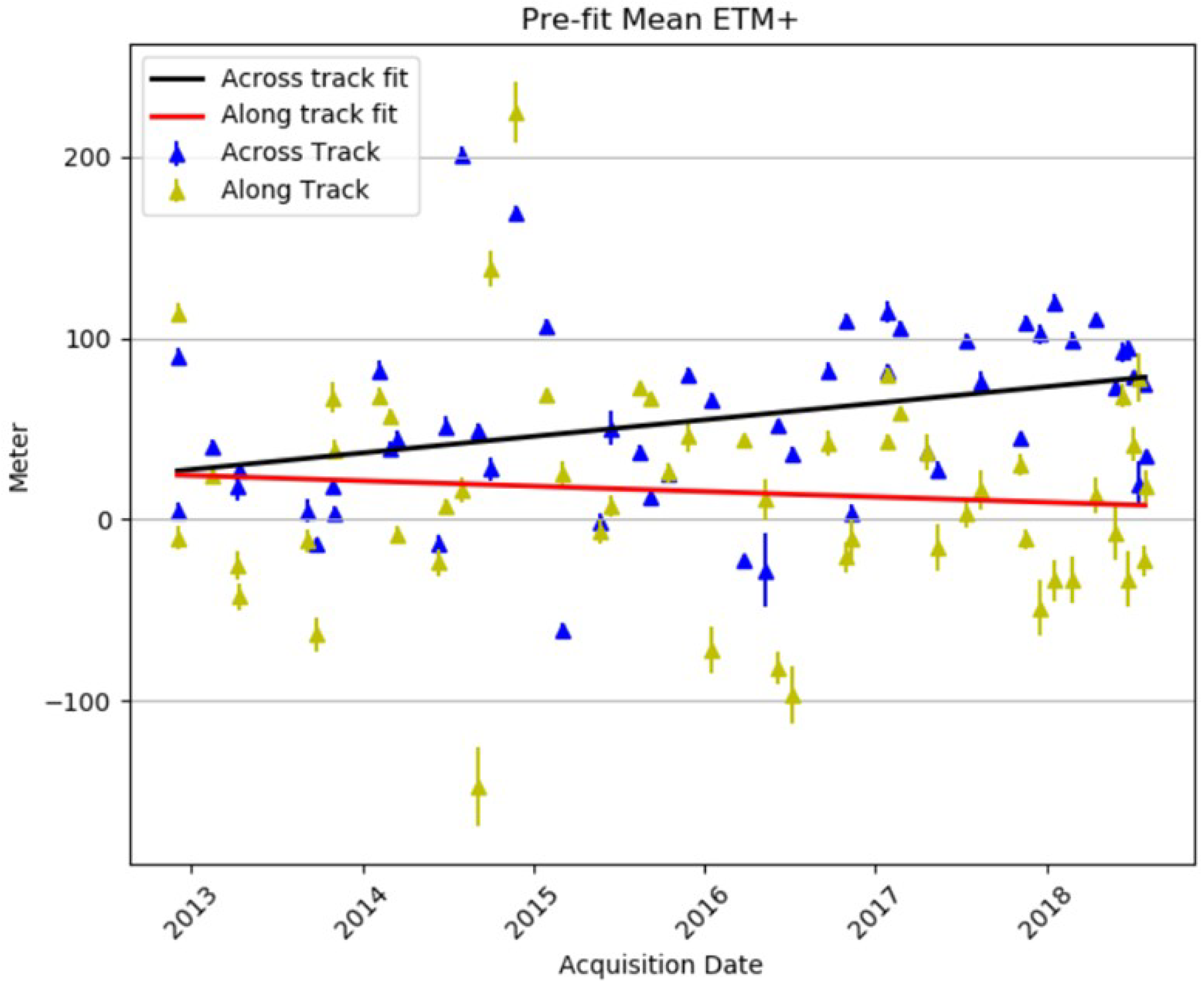
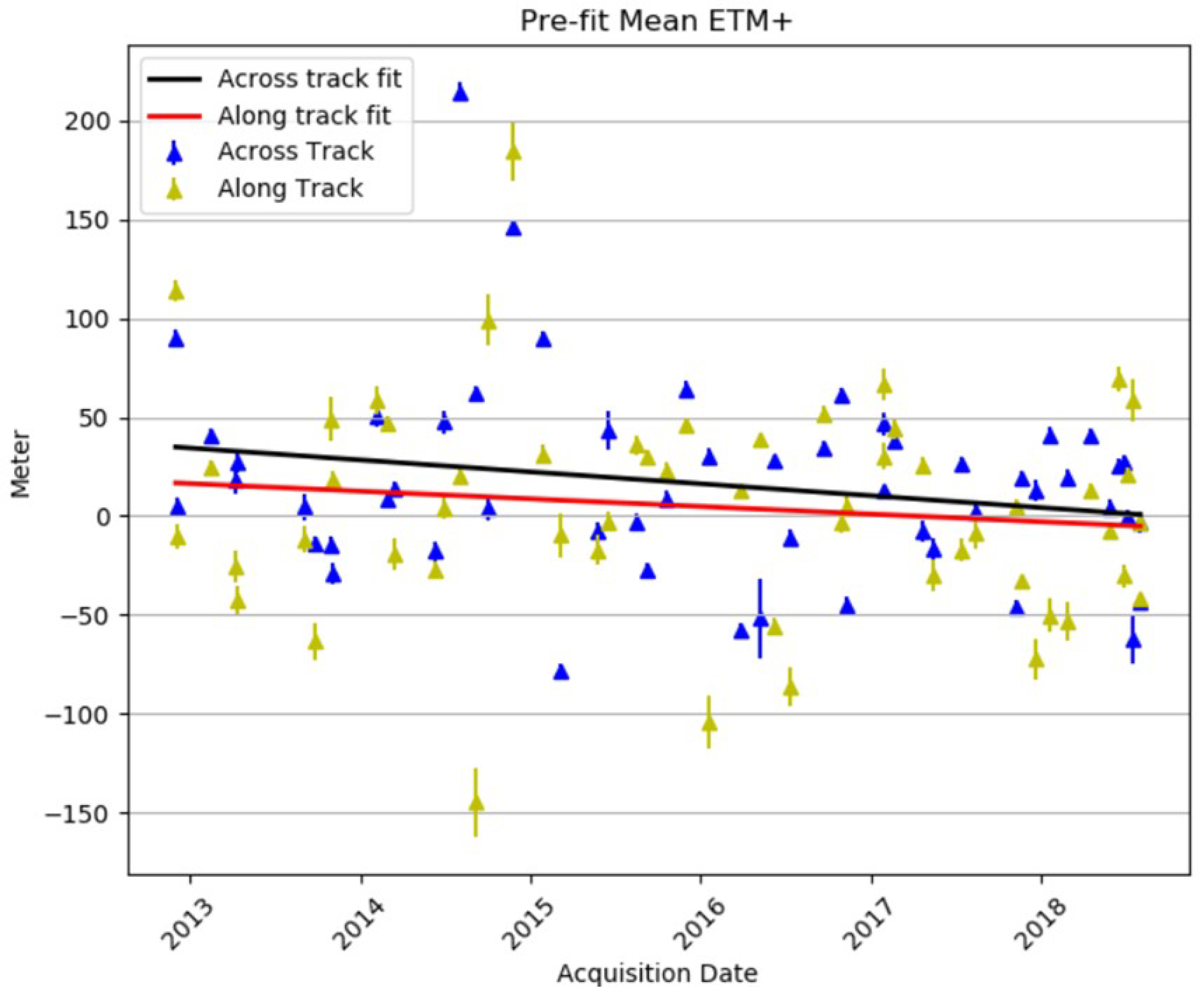
| Scan Direction | Detector Number | Offset IFOV |
|---|---|---|
| Forward | 1 | 0.008 |
| Forward | 2 | 0.166 |
| Forward | 3 | −0.023 |
| Forward | 4 | 0.012 |
| Forward | 5 | −0.031 |
| Forward | 6 | 0.091 |
| Forward | 7 | −0.087 |
| Forward | 8 | 0.111 |
| Reverse | 1 | 0.010 |
| Reverse | 2 | 0.135 |
| Reverse | 3 | 0.022 |
| Reverse | 4 | 0.085 |
| Reverse | 5 | −0.028 |
| Reverse | 6 | 0.100 |
| Reverse | 7 | −0.053 |
| Reverse | 8 | 0.088 |
| Scan Direction | Detector Number | CPF Focal Plane Offset (IFOV) |
|---|---|---|
| Forward | 1 | 1.915 |
| Forward | 2 | 2.191 |
| Forward | 3 | 1.860 |
| Forward | 4 | 2.174 |
| Forward | 5 | 1.941 |
| Forward | 6 | 2.060 |
| Forward | 7 | 1.823 |
| Forward | 8 | 2.071 |
| Reverse | 1 | 1.874 |
| Reverse | 2 | 1.713 |
| Reverse | 3 | 1.941 |
| Reverse | 4 | 1.794 |
| Reverse | 5 | 2.058 |
| Reverse | 6 | 1.791 |
| Reverse | 7 | 2.035 |
| Reverse | 8 | 1.821 |
Publisher’s Note: MDPI stays neutral with regard to jurisdictional claims in published maps and institutional affiliations. |
© 2021 by the authors. This work was authored as part of the Contributor’s official duties as an Employee of the United States Government and is therefore a work of the United States Government. In accordance with 17 U.S.C. 105, no copyright protection is available for such works under U.S. Law. This is an Open Access article that has been identified as being free of known restrictions under copyright law, including all related and neighboring rights (https://creativecommons.org/publicdomain/mark/1.0/). You can copy, modify, distribute and perform the work, even for commercial purposes, all without asking permission.
Share and Cite
Choate, M.J.; Rengarajan, R.; Storey, J.C.; Lubke, M. Geometric Calibration Updates to Landsat 7 ETM+ Instrument for Landsat Collection 2 Products. Remote Sens. 2021, 13, 1638. https://doi.org/10.3390/rs13091638
Choate MJ, Rengarajan R, Storey JC, Lubke M. Geometric Calibration Updates to Landsat 7 ETM+ Instrument for Landsat Collection 2 Products. Remote Sensing. 2021; 13(9):1638. https://doi.org/10.3390/rs13091638
Chicago/Turabian StyleChoate, Michael J, Rajagopalan Rengarajan, James C. Storey, and Mark Lubke. 2021. "Geometric Calibration Updates to Landsat 7 ETM+ Instrument for Landsat Collection 2 Products" Remote Sensing 13, no. 9: 1638. https://doi.org/10.3390/rs13091638






